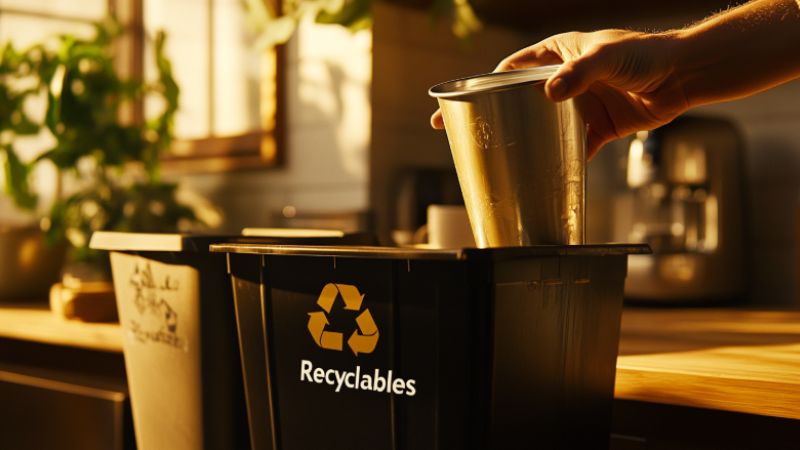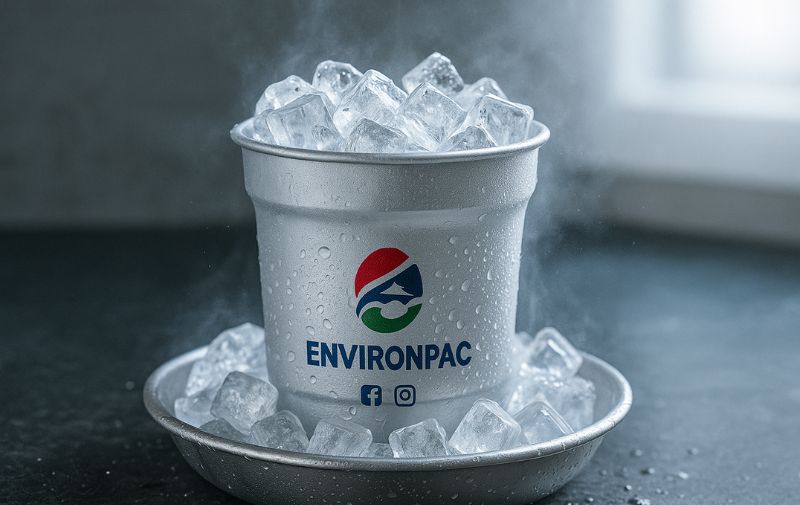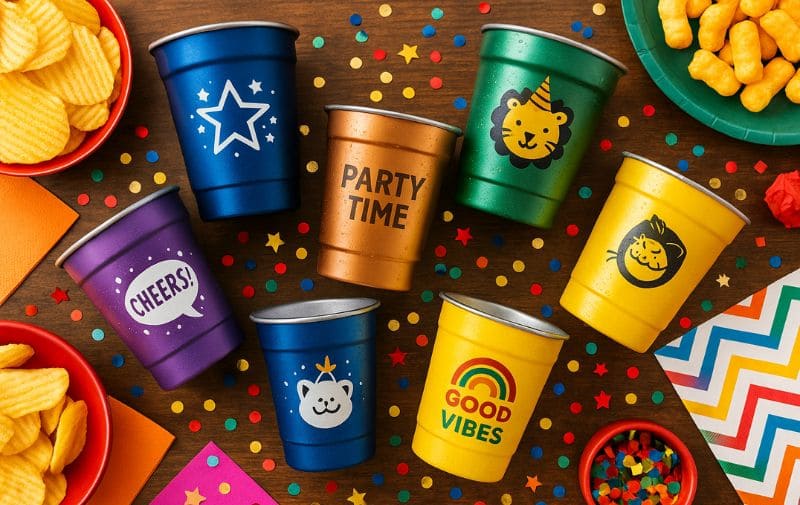Do not want to see heaps of disposable cups in landfills or want something to use that is eco-friendly? I have the best option for you then. A good reality is that aluminum cups are rapidly gaining in popularity among those who want to reduce their carbon footprint and impact on the environment.
Yes, aluminum cups can be recycled. They’re 100% recyclable and can be recycled many times over without losing quality. This makes them a great choice for sustainable drinkware options.
Aluminum cups offer many benefits beyond recycling. They are sturdy, are able to extend the period a drink remains cold, and facilitates several uses. I will delve into these benefits and much more throughout the rest of this article
Key Takeaways
- Aluminum cups are fully recyclable and can be recycled repeatedly
- They offer durability and temperature retention advantages over other materials
- Proper cleaning and recycling practices are crucial for maximizing their sustainability benefits

Benefits of Aluminum Cups
As much as they are great for the users, aluminum cups are equally beneficial to the environment. They serve their purpose effectively while being strong and serving the purpose of light weight cups.
Environmental Advantages
Aluminum cups are 100% recyclable, which means they can be melted down and reused indefinitely without losing quality. This depletion in waste and saved resources are what make aluminum cups a preferred choice. Additionally, the energy costs saved during the recycling of aluminum cups is substantially lower than that spent on producing new cups from scratch.
From my point of view, I have come to think that aluminum cups are more eco-friendly in the aspect of the amount of carbon emitted in the process of production and usage, than any single-use plastic cups. The global stakes of transporting aluminum cups are less because they are light. Even the production of aluminum cups doesn’t harm the environment significantly because many cups are made from recycled material.
Durability and Longevity
Aluminum cups are strong in the way that they last longer and are not easily broken or cracked, which makes them suitable for outdoor use. Unlike glass or plastic, which can shatter or crack, these cups are virtually indestructible, allowing them to be used at parties or events outside.
If I have used them in the past, I know that they are not as malleable as one would assume and do not get dented easily. Besides being used often, they do not rust or corrode and hence are in good condition.
The longevity of aluminum cups means you buy fewer replacements over time. This saves money and reduces waste. They’re also safe for hot and cold drinks, adding to their versatility.

Aluminum Recycling Process
To recycle aluminum is a straightforward exercise that has its own benefits of saving energy and material. Turning used metal into reusable commodity follows certain processes that will be elaborated on for clarity purposes.
Collection and Sorting
The first step in the process of recycling aluminum is collection and categorization of used aluminum products. It is clear that aluminum cups or cans may be the most common items as they are recycled many times round. There are households that recycle their cans by throwing them into their waste bins or bringing them to designated facilities.
Recycling centers also employ both people and machines that separate aluminum from other materials. Other things like paper labels or plastic lids are also scraped. This sorting guarantees that only virgin aluminum continues to the subsequent stage.
Other magnets attached to some of the cans that are non-magnetic also assist in the separation process. Different shapes and sizes of containers made of aluminum are compressed into bales for coming transportation.
Melting and Fabrication
Once sorted, the aluminum goes through melting and reshaping. Here’s how it works:
- The baled metal is taken apart our mutual goal into smaller components.
- These pieces go into large furnaces and melt at about 1,400°F (760°C).
- The molten aluminum is purified to remove any remaining impurities.
- It’s then formed into ingots or large blocks.
The ingots can be used to make new products. Recycled aluminum uses much less energy to produce than new aluminum. This makes it very eco-friendly.
Manufacturers can shape the recycled aluminum into new cans, foil, or other products. The quality of recycled aluminum is just as good as new aluminum.
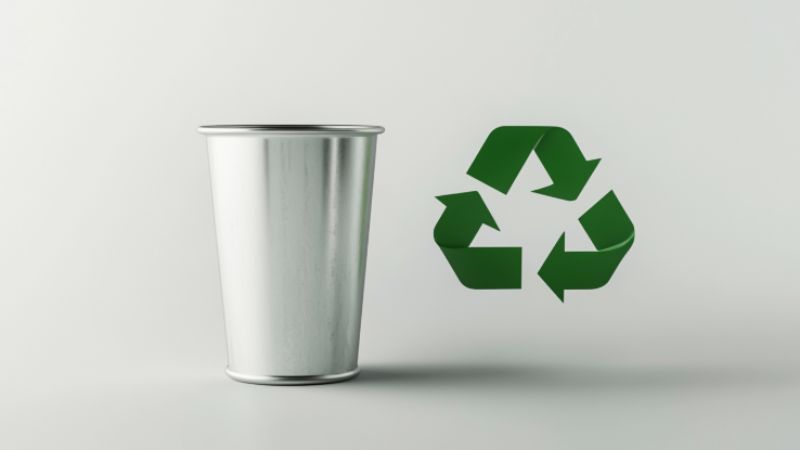
Comparative Analysis of Drinkware Material
Aluminum is not the only material used for Drinkware. There are several alternatives. Let’s see how aluminum compares to these materials.
Aluminum VS Plastic
There are many merits to the use of aluminum cups over plastic ones. They’re 100% recyclable and can be recycled indefinitely without losing quality. One cycle of recycling plastic does help the ocean, but some neglect to look at the bigger picture – another cycle dilutes its properties, damaging the material.
Aluminum has a lower carbon footprint in production and recycling. It uses less energy to recycle than creating new plastic. Plastic often ends up in landfills or oceans, harming wildlife.
Aluminum cups are more durable than disposable plastic. They can be reused many times, reducing waste. Plastic cups are usually single-use, contributing to pollution.
Aluminum VS Glass
Just like aluminum, glass can also be recycled – but at a cost of chewing a tedious mouthful of energy. Wait, there’s more! Glass weighs more – an unnecessary burden that increases transportation expenses. On a brighter note, aluminum grams’ weight helps sharply cut down carbon emissions made during transport.
Aside from being heavy, glass cans also shatter – a clear step backwards in harnessing aluminum cups. One of the most fascinating features of aluminum cups is the ability to resist being shattered. Overall, aluminum works well for outdoor events, as they are easy to carry around and shatter resistant.
Both materials are non-reactive with drinks, preserving taste. But aluminum cools drinks faster than glass, which is great for cold beverages.
Aluminum VS Stainless Steel
Aluminum and stainless steel are both remarkable materials as they are both robust and reusable. In terms of strength, stainless steel is a bit better, however, this makes it heavier also. On the other hand, aluminum is significantly lighter which makes it a better choice for outdoor usage.
Aluminium on the other hand is a better thermal conductor when compared to stainless steel. This translates to a quick cooling time for drinks placed in aluminium cups as opposed to those placed in steel cups which take a long time to cool If only placed in steel cups.
While both can undergo recycling processes, aluminium is said to be less hassle intensive and faster. The amount of energy used in recycling aluminium is also lower than the amount used in recycling stainless steel.
Aluminum solo cups are often cheaper than stainless steel. This makes them more accessible for large events or everyday use.
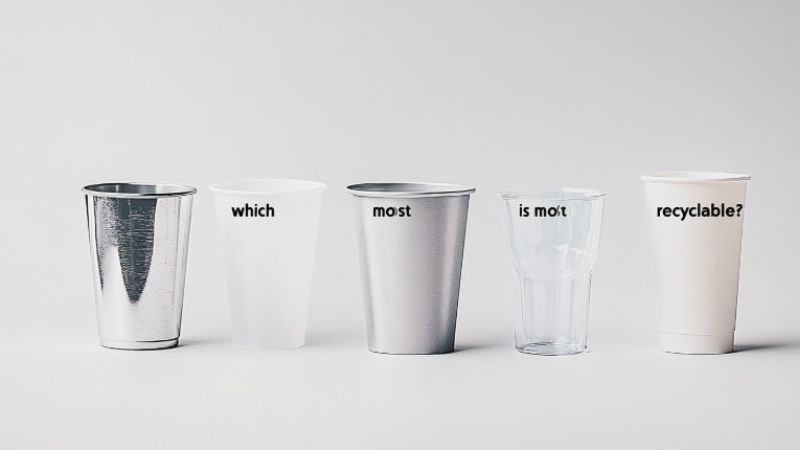
Alternatives to Aluminum Cups
While aluminum cups have benefits, other options exist for eco-conscious drinkers. Let’s look at some sustainable alternatives and disposable choices that can reduce environmental impact.
Sustainable Drinkware
I’m all for the use of reusable cups as it leads to a decrease in the amount of waste. For me, my go to would be stainless steel tumblers as they are thick and good for insulation. And for those who prefer a clean taste and easy to clean utensils, glass cups are a fine addition.
Ceramic mugs are a great go to for hot drink lovers, especially coffee drinkers. These cups are great for keeping a warm drink and come in various designs and shapes. In addition, being a bamboo cup offers a more natural approach which is good for the environment.
Some companies make cups from recycled plastic water bottles. These give plastic a second life while creating sturdy drinkware.
Silicone cups are durable and they do not take up a lot of space as they are foldable. These cups are ideal for outdoor activities and traveling.
Eco-Friendly Disposable Options
When reusable isn’t possible, eco-friendly disposables can help. Paper cups lined with plant-based materials break down easier than plastic-coated ones.
Made from sugarcane waste, Bagasse cups would make for a perfect substitute as they can decompose and are great to use for both hot and cold beverages.
PLA appears to be one of the best alternatives as it can be grown and does not come off as a nonrenewable plastic cup.
The first cup guarantees, at the end of the EDIBLE Seaweed or wheat bran composite based zero waste unit, there is no waste as the cup can be consumed after the beverage is finished.
Lastly sturdy palm leaf plates and bowls are perfect for serving food and drinks as they are natural and biodegradable.
Role of Aluminum Cups in Circular Economy
When it comes to using aluminum cups, they are integral to the circular economy. A lot of these cups I’ve discovered are recycled over and over without losing quality. This makes them very sustainable when it comes to drinkware.
The circular economy seeks to minimize waste and the continual use of resources. Aluminum cups were the perfect fit for this goal. They can be recycled into new products with high efficiency.
Some key benefits of aluminum cups in the circular economy:
- Infinitely recyclable
- High recycling efficiency (90%)
- Maintain material properties when recycled
- Cut demand for new raw material
A lot of aluminum drinking cups are now made from 90% recycled content. That means how efficient they are in a closed-loop.
By choosing disposable aluminum cups, I’m supporting a more sustainable drink container option. They help create a system where resources are used again and again, cutting down on waste.
The Aluminum Cup Recycling Challenge
Recycling these aluminum cups is not without challenges. These challenges can make recycling them more difficult.
Contamination Issues
I have come to learn that contamination is a huge concern of Aluminum Cup recycling. The cups often have food and drink matter on their surfaces which makes such cups not fit for use.
Dirt, grease and other things create some issues too. They can also be blended with aluminum during recycling. This in turn affects the quality of the recycled product.
Labels and coatings on some cups provide another obstacle. Those need to be removed before recycling the cups. Otherwise they may contaminate the aluminum.
Recycling Infrastructure
From my observations, many of the recycling centers are not equipped for aluminum cup disposal. They are targeted for can and other commonly available Items.
The equipment used for sorting may not be able to detect cups. Consequently, it can result in cups being directed in the wrong waste stream. Such cups are disposed of in landfills rather than being recycled.
Some places are bereft of such aluminum beer cup recycling programs. In such cases, people may not know how to recycle the cups properly. This invariably results in disposal of cups in the trash bin.
Replacing these recycling plants is a lengthy and costly process. Up till then, it is likely that the aluminum cup recycling rates will remain low.
Future of Aluminum in Sustainable Practices
The significance of aluminum in the sustenance of the environment is bound to increase. With a move towards eco-frien dly practices, I am certain, this metal will be deemed increasingly vital.
One of the approaches towards this future is the recycling of aluminum. It is absolutely recyclable and can be used over and over without losing its quality. This makes it ideal for a circular economy model.
Also, the energy efficiency is an additional advantage. The energy consumed in recycling aluminum is far less than energy consumed in smelting new metal. This actually abates greenhouse gases emission.
I have witnessed a greater number of manufacturers incorporating aluminum into their green products. A good illustration is the Ball aluminum cup. It is indeed an eco-friendly, recyclable alternative for single-use plastics.
Aluminum is becoming increasingly popular among manufacturers as a substitute for plastic in the packaging industry. It is lightweight, which reduces transportation costs, and it has a better recycling value than other materials do.
As time goes by, I expect to see:
- More aluminum used in electric-mobility systems
- Greater usage in construction materials
- New developments in aluminum recycling methods
Will aluminum lead the way to a greener future?
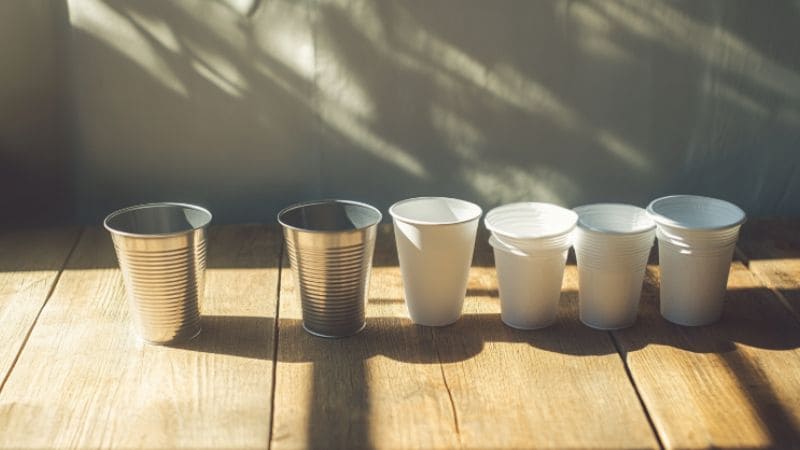
Frequently Asked Questions
How should aluminum cups be processed for recycling?
I would advise rinsing the aluminum cups as this helps get rid of food and liquids stuck to the cup. It is beneficial to crush the cups, but it’s not essential. Most materials recovery facilities can deal with cups either whole or crushed. We recommend checking with your local program to determine any specific requirements.
Are there any regional differences in recycling aluminum cups in the United States?
Yes, to some extent. For instance, in Cincinnati they are now allowing disposable aluminum cups in curbside collection. You should contact your local authority to find out whether aluminum cups are included in your recycling program. Other regions may require that aluminium cups be taken to designated aluminium cup recycling centers.
What makes aluminum cups a better choice for recycling compared to other materials?
Aluminum cups are recyclable without any quality loss and can be done many times. This is an advantage over plastics which have a reduced quality every time they are used. Also, aluminum cups do not break as easily as paper ones. As a result, I consider aluminum cups to be a eco-friendly way to replace plastic cups or paper cups.
How does the recycling process for aluminum differ from that of other metals?
Aluminium possesses a distinctive manner of undergoing the recycling process. It is said that aluminum has an indefinite life span as it can be melted and recast over and over again without losing any of its quality features. I find the process of reusing aluminum can be less energy intense than the process of extracting aluminium components out of raw materials.
What are the environmental benefits of recycling aluminum cups?
There are considerable ecological gains from the recycling of aluminium cups. This is equivalent to about 1,024 gallons of gas. Not only this, I see the recycling of aluminium as providing a solution to reducing the cutting down of bauxite ore, saving energy, and minimizing greenhouse gas emissions.
Conclusion
Aluminum cups are highly recyclable. They can be recycled many times without losing quality. This makes them a sustainable choice for events.

